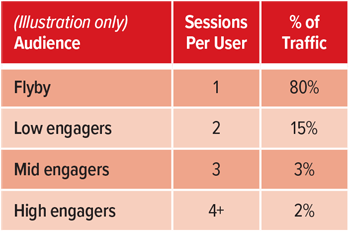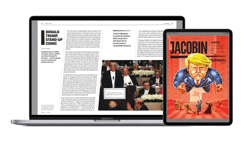
We live in a subscription economy; business after business is looking to recurring revenue models to strengthen their customer revenue strategies. Traditional print publishers with complex ‘sticky plaster’ tech solutions and those that have been slow to adapt to digital-first publishing models are finding it particularly challenging to be agile in this attention economy. Successful subscription strategies are reliant on a test and learn approach; it is almost impossible to determine whether a paywall or registration wall or even open access is right for you without swapping out your tech stack – or is it?
The start of the journey
I first dipped my toes into the world of paywalls around seven years ago, before joining New Scientist. Working on a proof of concept project, we chose two publications with high website traffic that didn’t put magazine content on their websites. The hypothesis being, if we put premium magazine content on the website and added a meter, we could turn repeat visitors in to digital subscribers. Visitors could access three free articles in a month, they would eventually hit their meter limit and see a subscription message putting us on the road to digital subscriber growth.
Whilst the thinking was sound, it did not deliver on expectation because we didn’t act upon some critical insight. Very few visitors returned; flyby traffic was over 95% and most read just one article. The lesson we learned was, just because you want digital subscribers doesn’t mean you’re going to get them because you put a paywall up. Use the data to inform your strategy. If we knew then what we know now, we would have introduced a registration strategy first. But digital subscription growth was the objective, we didn’t get it, so the project was shelved.
Early years at New Scientist
Roll forward to 2018, I joined New Scientist where they operated a hard paywall. Traffic would land on either free or paywalled content and editorial strategy included testing what content goes in front and what goes behind the paywall (though New Scientist’s high-quality, expertly researched and written features have always been, and remain, behind the paywall).
Our subs approach has always been to align with the overall business strategy. The hard paywall I inherited supported the business strategy of ‘profitable subscriber growth’, with free content being available for visitors not quite ready to commit to a subscription. My first 18 months focused on optimising conversion to paying subscriber.
With editorial testing varying ratios of free versus paid content, marketing focused on testing conversion initiatives: ie. onsite messaging, gift with purchase, monthly, quarterly, and annual offers and taking a lifetime value approach to trial offers by testing trial take up and pay up rates. We spent a lot of time testing and monitoring subsequent churn and retention rates with a view to delivering profitable subscriber growth.
This strategy worked very well, consistently delivering profitable subscriber growth; through Covid, we enjoyed double digit acquisition growth and strong retention rates as our offer strategy aligned with profitable subscriber growth.
However, in early 2022, we came to realise that to achieve continued growth, we needed to think about our overall audience strategy and develop strategies that supported audience growth as well as audience conversion.
We had started to see a slow-down in conversion of our paid digital marketing channels with cost-per-acquisition increasing. Our thinking was the audience was not quite understanding what we had to offer or seeing the value in subscribing, requiring the need to rethink our messaging and customer journey.
We began testing upper funnel lead generation, promoting popular content and creating journeys that focused on registration or newsletter sign up; the hypothesis being, if we could nurture our prospects in to understanding what New Scientist has to offer, we could increase their propensity to subscribe.
In this, having a very well-crafted conversion strategy enabled us to shift our focus to developing these new top and mid-funnel strategies.
Our new approach – audience growth
You need the right technology to build an audience strategy. The challenge we faced was that we had a rigid platform; content is either ‘free’ or ‘paywalled’, nothing in between. Visitors could create an account but didn’t need to to read free content; there was no real value exchange for creating an account other than to receive a newsletter and the process wasn’t, in truth, a frictionless customer experience. Having to provide more than your email address and creating a password to sign up to one of our newsletters was an off-putting and clunky experience.
We knew we had to improve the value exchange and the experience to grow our audience, but the technology restricted this.
We wanted to avoid building lengthy business cases for new technology or launching new products and services. Our first port of call therefore was simply using our existing DMP to identify segments of opportunity and working with our internal tech team to simplify the journey and remove friction where possible. We also bolted on customer journey orchestration technology to enable us to start customising messaging to segments identified as high opportunity.
We started with our existing toolkit, improving the newsletter sign-up journey by removing the need for visitors to create an account to receive them. We also added a range of topic focused newsletters messaging for those visitors unfamiliar and possibly less interested in our wide-ranging content newsletters – the hypothesis being, if we segmented our content, giving visitors more of what they enjoyed and making it easier for them to find, and receive in their inbox, we could drive higher engagement, which would lead to subscription conversion.
We also knew that we needed technology to enable better discovery, so we took an iterative approach by bolting on customer journey functionality enabling us to test segmented journeys for our visitors. This allowed us to serve appropriate messages to sign up to newsletters (‘Healthcheck’, for example, if you are reading health content) as well as test registration for free content.
We started by building simple journeys, identifying data sets using our DMP. We targeted repeat visitors who had consumed two specific topic-based free articles in a 30-day period. We also tested hard and soft registration of first-time visitors as well as format and messaging. This testing was with a view to us establishing a control journey for each of our unknown audience segments which we split in to four buckets:

For the next step, we created simple onward email journeys, building up data over time and pushing them through the onward journey to establish the conversion behaviours of the different data sets.
Early learnings
Registration walls will certainly increase your data but will not necessarily lead to engagement and conversion. We monitor bounce rate from articles to help us understand the quality of our data; we found that visitors coming via ‘hard registration’ had higher bounce than via ‘dismissible’, thus, we concluded, forcing registration is not likely to increase engagement overall. ‘Dismissible’ might collect fewer names, but the bounce was much lower in comparison to ‘hard’. Our take from this was, we are collecting more valuable data from those who go on to read the article than those who must register and then bounce almost immediately.
This is also supported when we analyse the results of the onward email journeys. We found that our registration wall generates the highest volume of registrations and subscriptions of all registration sources but has the lowest conversion rate. Those who sign up to a newsletter as their first point of data capture is the next with the ‘Create Account’ form in 3rd place; volumes are lower but conversion higher on the subsequent two.
This is invaluable insight in helping us shape our future registration strategy and our testing plan to support the business strategy. We now have a greater understanding of how long it takes each data set to subscribe and the conversion of each of these enables us to forecast future subscriber growth from this strategy.
App strategy
Much of our focus has been on the website, and rightly so, with over 50m global visitors a year but this isn’t the sole way to engage with our content – we also have an app.
Previously, our focus had been on driving direct to publisher subscriptions, choosing to make it more cost effective for customers to buy direct from us as this enables us to develop a relationship with customers. Revisiting our toolkit, we saw an opportunity to align the app strategy with our objectives of increasing audiences, giving customers the opportunity to engage with our content in the way they prefer and not penalise them for purchasing through 3rd parties like Google and Apple. We updated the app, bringing in content from the website, improving content discoverability and adding additional functionality such as audio and metering to enable sampling of premium content. We are at the start of this journey, but early results are showing positive engagement, increased downloads and subscription growth.
The immediate future
Through 2023, we will continue to develop our audience strategy here at New Scientist. We are living in very challenging times and whilst the conversion focused strategy has served us well in the past, the audience building strategy will serve us well in the future. Our objective is to build demand now, so we have an audience to convert in the future when the economy eventually bounces back.
Customer engagement is our North Star. Our philosophy is, engaged users eventually become engaged subscribers. Our content is our enabler and therefore our strategy is to introduce a wider audience to New Scientist by inviting prospects to try New Scientist content across multiple platforms. We target direct sales where appropriate and data collection at the start of their New Scientist journey, opting to nurture our prospective customers, building relationships and their understanding of the value exchange.
Our early testing has helped secure further investment in our technology stack. We are very close to going live with an upgraded subscriptions management platform that will enable us to integrate our bureau with market leading digital subscription management technology.
We are aligning our operations around the delivery of this strategy as well as our resources. The marketing team today has a whole host of new skills and capabilities in comparison to when I joined in 2018; our skills are evolving as our strategy evolves, this too is fundamental to its success.
A key takeaway for me from this journey is, marketers work with clunky tech stacks and imperfect data every day; what we lack here in terms of stack perfection, we make up for in bucket loads of ideas and an abundance of patience. We refer to our “toolkit” a lot at New Scientist. My advice is, explore your toolkit, identify what you can do rather than what you can’t do and get testing.
This article was first published in InPublishing magazine. If you would like to be added to the free mailing list to receive the magazine, please register here.












